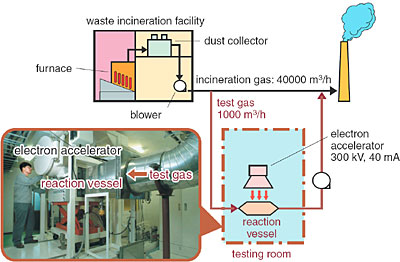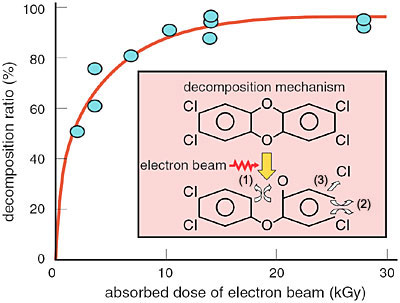Dioxin, usually generated by waste incineration, has a toxicity more than ten times greater than sarin and has further effects as an endocrine disruptor (so-called environmental hormone), even at a very low concentration. It is also known to remain toxic for a long period of time in the environment because of low bio-degradability. Although the Japanese Ministry of the Environment has begun strict regulation of dioxin emission, the same as in Europe and the USA, cheap and effective technologies to reduce dioxin contamination have not yet been developed. It has consequently been unavoidable to terminate the operation of many small and medium-sized incinerators.
JAERI has developed various environmental purification technologies using electron beams, such as the reduction of acid rain by removing pollutants from combustion gases emitted by thermal power plants, decomposition of toxic volatile organic compounds contained in ventilation gases from industrial plants, etc. Based on these activities, trials have been started using similar methods to decompose dioxin.
To conduct testing using actual incineration gas, a pilot-scale plant with a low energy electron accelerator, an irradiation vessel, various gas analyzers and gas tubing was constructed on the premises of a waste incineration facility. As a parallel program, basic research has also been carried out using model compounds in order to clarify mechanisms of decomposition. Our intensive study shows for the first time ever that dioxin in waste incineration gas can be effectively decomposed by electron beam irradiation. Information on the decomposition mechanism and on toxicity reduction has also been obtained. Finally, optimum treatment conditions required for plant design, i.e., the relation between decomposition and gas temperature or flow rate, have been determined. Electron beam treatment has advantages of low treatment cost, easy attachment to a conventional incinerator, and avoidance of secondary contamination because of direct decomposition of the dioxin.
Currently, JAERI is making an effort to commercialize this technology through cooperation with a private company.
|


